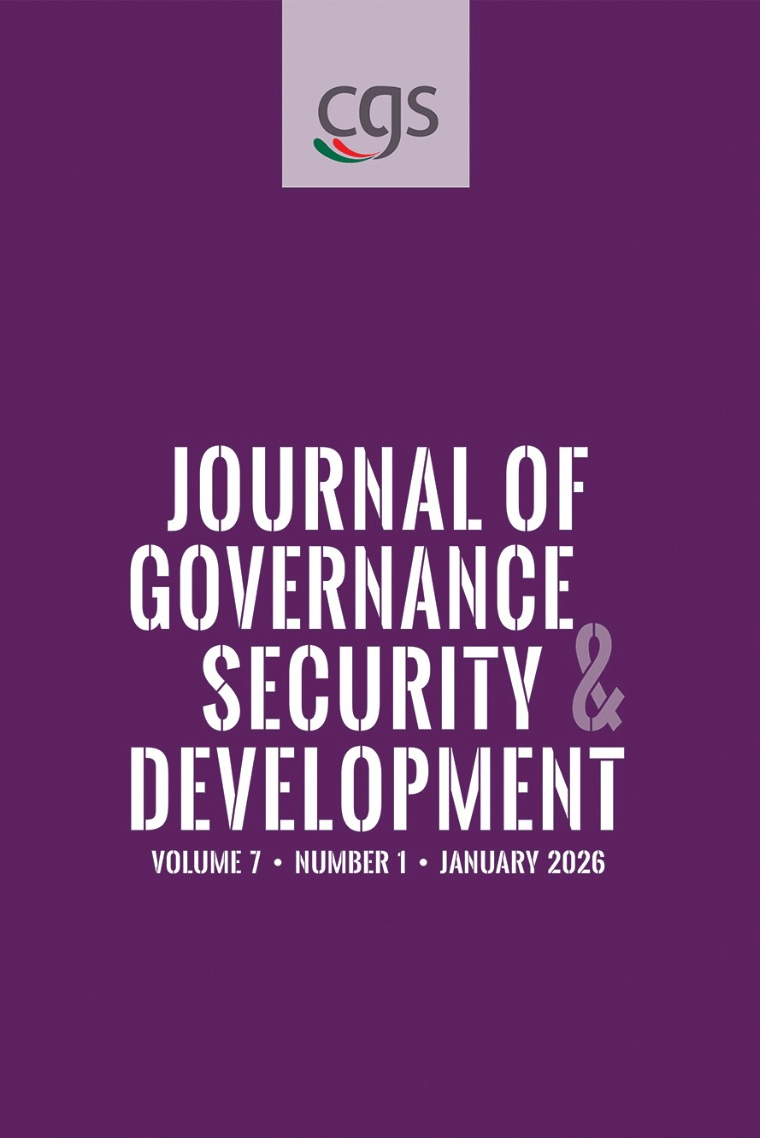Journal Reference
Volume 6 | Number 1-2
Online Version: ISSN No: 2708-2490
Print Version: ISSN No: 2709-0590
Price: BDT: 750.00, USD: 25.00
Publish Date: 01, July 2025
Article:
Shah Md Azimul Ehsan and Sadia Khanom
Reference
Ahmed, M. S., Rahman, N. T., & Rahman, K. W. (2021). Employment and Expectations of Former Madrasah Students in Cox’s Bazar: A Cross-Sectional Exploration, BIGD, BRAC, Dhaka
Al-Hasani, S. M. A. (2020). Madrasah education in Bangladesh: A comparative study between Aliya and Qawmi, Journal of Creative Writing, 4(2):111-132.
Ali, I., Anwar, M. & Sharmin, T. (2021). Job Opportunities and Obstacles of Madrasah Graduates in Bangladesh. International Fellowship Journal of Interdisciplinary Research, 1(1): 36-47.
Becker, G.S. (1964). Human Capital. Chicago, IL: The University of Chicago Press.
Bol, T. (2015). Has education become more positional? Educational expansion and labour market outcomes, 1985–2007. Acta Sociologica, 58(2): 105-120.
Bol, T., Ciocca Eller, C., Van De Werfhorst, H. G. & DiPrete, T. A. (2019). School-to-work linkages, educational mismatches, and labor market outcomes. American Sociological Review, 84(2): 275-307.
Braun, V., & Clarke, V. (2013). Successful qualitative research: A practical guide for beginners. Sage.
Braun, V., Clarke, V., Boulton, E., Davey, L., &McEvoy, C. (2021). The online survey as a qualitative research tool. International Journal of Social Research Methodology, 24(6): 641–654. https://doi.org/10.1080/13645579.2020.1805550
Braun, V., & Clarke, V. (2021). Can I use TA? Should I use TA? Should I not use TA? Comparing reflexive thematic analysis and other pattern‐based qualitative analytic approaches. Counseling and Psychotherapy Research, 21(1): 37-47. https://doi.org/10.1002/capr.12360
Begum, G. (2017). Curriculum of Madrasahhs and its Nexus with Unemployment Problems and Possibilities [Unpublished Thesis]. Department of Political Science, University of Dhaka.
Brown,P.&Souto-Otero,M.(2020).Theendofthecredentialsociety?Ananalysisoftherelationship between education and the labour market using big data. Journal of Education Policy, 35(1):95-118.
Bourdieu, P. & Passeron, J. (1977). Reproduction in Education, Society, and Culture. Beverley. Hills, CA: Sage Publications.
Chowdhury, S.J. (2017). Bangladesh: Is recognising QMs mainstreaming or appeasement? Available at
https://www.wionews.com/south-asia/bangladesh-is-recognising-Qawmi-madrasahs- mainstreaming-or-appeasement-15890 (Accessed 12 January 2025).
Creswell J. W. (2014). Research Design: Qualitative, Quantitative and Mixed Method Approaches (3rd ed.). SAGE Publishers.
Daily Star. (2018). ‘Three of four madrasah students remain jobless’. Daily Star, 28 January. Available at https://www.thedailystar.net/city/every-3-four-madrasah-students-remain-jobless-1526140(Accessed 12th January 2025).
Daily Star (2018a). ‘Master’s Status for Top Qawmi Degree: Towards legal recognition. Daily Star, 20 September.Available at https://www.thedailystar.net/news/country/bangladesh-cabinet- approves- bill-recognising-Qawmi-madrasahhs-dawrae-hadith-1620178 (Accessed 12 January 2025)
Daily Star (2018b). 1010 Qawmi graduates join government jobs. Daily Star, 5 March. Available at
https://www.thedailystar.net/backpage/1010-Qawmi-graduates-join-govt-jobs-1543486
(Accessed 12th January 2025)
Daily Star (2021). Govt hosts first ever dedicated it training course QM students. Daily Star, 16 June. Available at https://www.thedailystar.net/toggle/news/govt-hosts-first-ever-dedicated-it- training (Accessed 12 January 2025).
Dhaka Tribune (2018) Experts: Modernizing Qawmi education more important than upgrading certificates. Dhaka Tribune, 7 October. Available at https://www.dhakatribune.com/bangladesh/ education/157552/experts-modernizing-Qawmi-education-more (Accessed 12 January 2025)
Ehsan, S. M. A. (2021). Revisiting tertiary education system in Bangladesh: In quest for unravelling existing Issues and challenges. Journal of Contemporary Governance and Public Policy, 2(1): 45-66.
Ehsan, S. M. A., Hossain, F., Eldridge, D., & Bhuiyan, S. (2022). Advancing public service innovation through empathy: An analysis of Bangladesh’s intrepid approach. South Asian Journal of Human Resources Management, 9(2): 250-270. https://doi.org/10.1177/23220937221113993
Freeman R. (1976). The Overeducated American. New York: Academic Press.
Golam, A. M., & Kusakabe, T. (2020). Improving the Efficacy of English Instruction at QMs (Islamic Seminaries) in Bangladesh. SAGE Open, 10(2): 1-15. https://doi.org/10.1177/2158244020924049
Ho, K. Z. (2009). Liquidated: An Ethnography of Wall Street. Durham, NC: Duke University Press.
Hoque, M. R., Sarder, S., & Amin, F. (2023). Curriculum Development in Madrasah Education: A Comparative Study with Mainstream Education in Bangladesh, Journal of Socio-Educational Dynamics, 1(1): 1-13.
Hussain, A. A. (2018). State, QM and children in Bangladesh from a social protection perspective. [Unpublished Master’s Thesis]. International Institute of Social Studies (ISS), Erasmus University Rotterdam, The Netherlands. http://dx.doi.org/10.13140/RG.2.2.31891.30245
Islam, R (2019). Master’s equivalency of QM (NIZAMMIA) Education in Bangladesh: Exploring the Controversies and Challenges. In Proceedings of International Asia-pacific Symposium Politics, Economics and Social Structures of South Asia (pp. 203-204). Istanbul.
Kitzinger, J. (1995). Qualitative research: Introducing focus group. BMJ, 311(7000): 299–302.
https://doi.org/10.1136/bmj.311.7000.299
Morley, L. & Aynsley, S. (2007). Employers, quality and standards in higher education: Shared values and vocabularies or elitism and inequalities? Higher Education Quarterly, 61(3): 229-249.
Nag, S. (2020). Bangladesh’s dangerous Islamist appeasement – And what it portends. The Diplomat,
22 December. Available at https://thediplomat.com/2020/12/bangladeshs-dangerous-islamist- appeasement-and-what-it-portends/ (Accessed 12 January 2025).
Rivera, L. A. (2011) Ivies, extracurriculars, and exclusion: Elite employers’ use of educational credentials. Research in Social Stratification and Mobility 29(1): 71–90.
Raqib, A. A. Islam, M. O. & Ali, M. A. (2015). Perception of different stakeholders and classroom practice of QM education. NAEM Journal, 10(19): 1-11.
Ruman, M. A. K. & Bhuiyan, M. A. (2015). Ebtedayee English syllabus under BEFAQ: An evaluation.
Bangladesh Research Foundation Journal, 4(1): 14-30.
Shakil, T.S. & Hossain, C.A. (2020). Three years of Qawmi degree: How is govt recognition reflected in society? Bangla Tribune. Available at https://en.banglatribune.com/national/news/89185/Three- years-of-Qawmi-degree-How-is-govt (Accessed 12 January 2025)
Shaon, A.I. (2018). What are madrasah students actually learning? Dhaka Tribune, Available at https://www.dhakatribune.com/bangladesh/bangladesh-others/135884/what-are-madrasah- students-actually-learning (Accessed 12 January 2025).
Selvi, A. F. (2019). Qualitative content analysis. In The Routledge Handbook of Research Methods in Applied Linguistics (pp. 440-452). Routledge.
Saunders, M., Lewis P. & Thornhill, A. (2009). Research methods for business students (5th ed.). Pearson Education.
Tholen, G. (2017). Symbolic closure: Towards a renewed sociological perspective on the relationship between higher education, credentials and the graduate labour market. Sociology, 51(5): 1067-1083.
Tholen, G., Brown, P., Power, S., & Allouch, A. (2013). The role of networks and connections in educational elites’ labour market entrance. Research in Social Stratification and Mobility, 34: 142-154.
Utton Trust (2009). The educational backgrounds of leading lawyers, journalists, vice chancellors, politicians, medics and chief executives. The Sutton Trust. https://www.suttontrust.com/wp- content/uploads/2019/12/ST_MilburnSubmission-1.pdf
Weber, M. 1978. Economy and Society. Berkeley: University of CaliforniaPress.
WongL.P.(2008).Focusgroupdiscussion:Atoolforhealthandmedicalresearch.SingaporeMedical Journal, 49(3): 256–260.https://doi.org/10.1046/j.1365-2648.1996.12213.x
Yin R. K. (2010). Qualitative Research from Start to Finish. SAGE Publishing.


